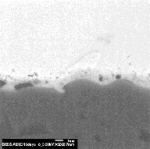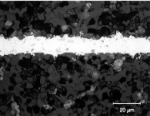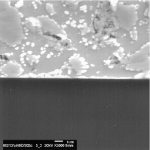S-BOND TECHNOLOGY
Solder Joint Structures
Electronic Materials
Silicon Bonding-Silicon Soldering-Semiconductor
Electronics use a range of metals, ceramics and an increasing proportion of composite materials for function and to thermally manage electronic and opto-electronic packages. The joint structures depicted in this section show some joints with typical materials that are used in electronic packages and in electronics, including alumina (Al2O3), aluminum nitride (AlN), silicon, silicon carbide, aluminum, copper and many other metals.

The joint to the left illustrates the structure of the S-Bond® Alloy 220 joined to alumina, used as a substrate material in chips and other devices. The alumina base has been wetted and bonded with SB220, which is potentially useful in direct solder die attach, enabling excellent potential for device manufacture.

Aluminum nitride (AlN) is an emerging electronic substrate material and is becoming the substrate of choice in power electronic devices that carry and switch more current and thus generate more heat. AlN is more thermally conductive than alumina and performs better spreading and conducting the heat away from the Si devices. S-Bond has been found to join AlN to itself and to many metals and composites. The joint structure at left shows the good interface interaction, a condition for good bonding.

Electronic packages often involve the joining of copper to aluminum oxide. The joint structure depicted to the left demonstrates that S-Bond Alloy 220 can produce such joints.

S-Bond easily wets and adheres to silicon from 115 – 400C with the different S-Bond alloys. More recently, S-Bond 220M has been developed for silicon bonding and semiconductor soldering and glass. The photomicrograph illustrates how phases have preciptated on the silicon surface, lowering the surface interfacial energy and thus increasing the adhesive forces at the silicon S-Bond interface. This capability to direct solder die attach provides S-Bond excellent potential for device manufacture.
Contact Us to discuss S-Bond’s solutions for silicon bonding, silicon soldering, semiconductor bonding and other combinations of electronic materials.
Additional information and updates can be found in our Technology & Applications White Paper section ando our Blog.
More Information?
If you would like someone to contact you or provide information, please submit the information to the right.
